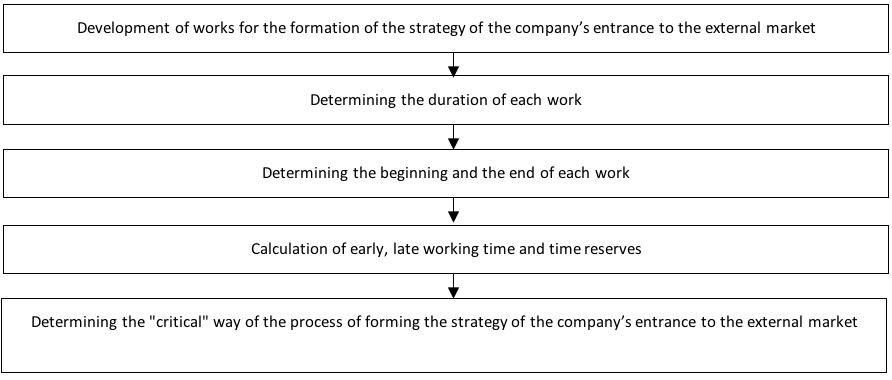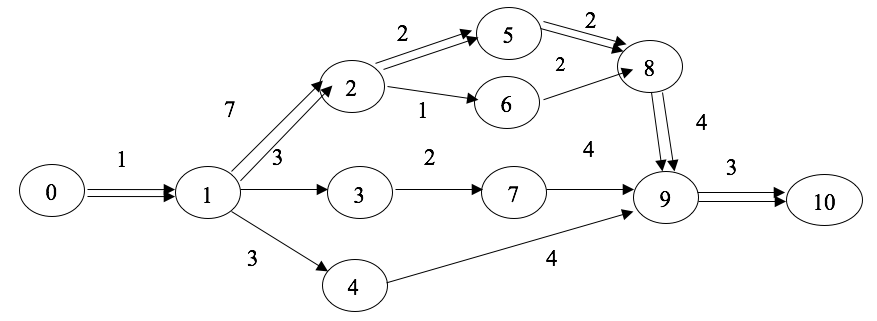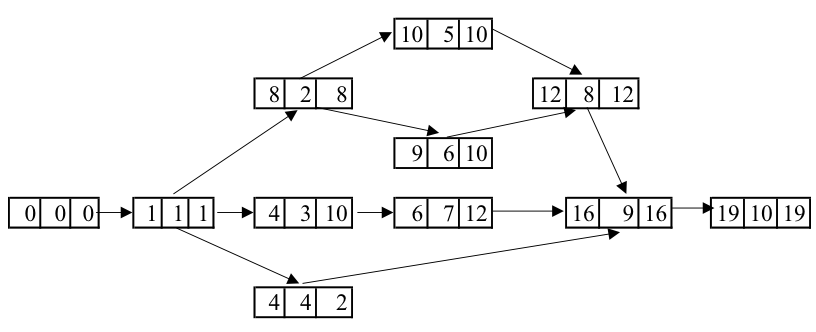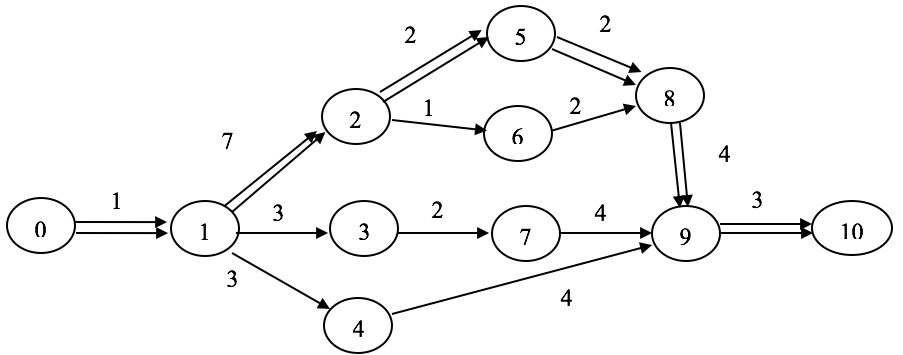

 Vol. 39 (Number 12) Year 2018. Page 23
Vol. 39 (Number 12) Year 2018. Page 23
Tatyana V. SHTAL 1; Ludmila M. BONDARENKO 2; Galiya S. UKUBASSOVA 3; Yerzhan AMIRBEKULY 4; Zukhra G. TOIBOLDINOVA 5
Received: 10/01/2018 • Approved:30/01/2018
ABSTRACT: The article introduces the famous scientists approaches to the "enterprise strategy" concept. The stages of forming the strategy of the company’s entrance to the foreign market were developed. The method of network planning, which is characterized by the definition of the beginning and the end of each work, the calculation of time reserves and the definition of the "critical path" – the maximum path from the initial to the determined event, was used. The method allowed establishing the degree of influence of the "time" factor on the process of forming the enterprise’s entrance to the foreign market strategy. |
RESUMEN: El artículo presenta los enfoques científicos famosos sobre el concepto de "estrategia empresarial". Se desarrollaron las etapas de formación de la estrategia de entrada de la empresa al mercado externo. Se utilizó el método de planificación de la red, que se caracteriza por la definición del comienzo y el final de cada trabajo, el cálculo de las reservas de tiempo y la definición de la "ruta crítica", la ruta máxima desde el evento inicial al determinado. . El método permitió establecer el grado de influencia del factor "tiempo" en el proceso de formación de la entrada de la empresa a la estrategia del mercado externo. |
Due to the growing competition in the domestic and foreign markets, and peculiarities of our country in the process of integration into the world economy, associated with this, the management practice increases the need to solve strategic problems related to the international economic activity of firms. The need to study the "time" factor when forming the strategy of the company’s entrance to the external market becomes of particular urgency, in such conditions.
Theoretical and methodological basis for the study of the "strategy" concepts, "strategy of enterprise’s entrance to external markets" and "factors influencing the formation of the strategy" are provided by such foreign scientists as
I. Ansoff, K. Andrews, B. Carlof, K. Omaye, M. Porter, S. Hofer, A. Chandler. Among Ukrainian and Russian scholars who researched this, we can note L.V. Fomchenkova (Fomchenkova, 2015, p. 159-160), A.V. Klochkova (Klochkova, 2016, p. 76-81), N.O. Jabbarova (Domozhilkina and Dzhabbarova, 2016, p. 139-142), S.M. Sycheva (Syicheva and Brausove, 2016, p. 220-224), N.E. Tarasova (Tarasova and Serdyukova, 2016, p. 175-179), A.N. Rezchikova (Rezchikova, 2016), I. Saukh (Saukh, 2016, p. 145-151), M.O. Boyarskaya (Boiarska, 2015, p. 306-310), Yu.M. Melnyk (Melnyk, 2015, p. 67-72), L.S. Ladonko (Ladonko and Hanzha, 2015). The time factor in the formation of strategies was investigated by V.V. Kiriy (Kiriy and Gutsa, 2016), V.A. Morozova (Morozova, 2016, p. 26-43), Tyhanov Yu.P. (Tihonov, 2015, p. 384-388) and others.
But the issue of the use of this speaker in the strategic management of international enterprise activities still needs to be further developed.
The practical value of the work lies in the possibility of using the proposed recommendations for the entrance of enterprises into the foreign market, which allows to ensure their competitive functioning and sustainable development.
Strategy formation, in conditions of dynamic development, occurring in the external and internal environment of the enterprise, is one of the crucial tools that help it not only to save but also to improve its position in the market. Strategy formation lies in the developing of a certain vision of the enterprise’s future development, as well as the use of advanced management methods. This, in turn, will allow for the most profitable development vector, which will bring the most effective economic results.
Table 1
Approaches of well-known scientists to the definition of "enterprise strategy"
Authors |
Definitions |
Strategy as a plan, a set of rules of decision-making and direction of development |
|
N. Tarasova
|
Strategy is a long-term plan of action that defines the priorities of strategic objectives, resources and consistency of steps to achieve the strategic goal (Tarasova and Serdyukova, 2016, p. 175-179). |
Strategy as a system |
|
I. Saukh |
Strategy is a system of formalized and unformalized management decisions, which is formed within the chosen direction of activity, is aimed at achieving long-term enterprise goals, formed with taking into account the influence of external environment's factors and the achieved potential of the enterprise (Saukh, 2016, p. 145-151) |
Strategy as a program of operation of the enterprise in the external environment |
|
S.M. Sychova |
Strategy is a general development program designed for a balanced interaction of the company with the external environment and competitive environment, which contributes to the achievement of long-term business goals in conjunction with the internal capabilities of the company, based on their rapid adaptation to the internal requirements of the economic, political and social space (Syicheva, S.M., Brausove, 2016, p. 220-224). |
Strategy as an ideology |
|
H. V. Strokovych |
Strategy is the ideology of development, qualitative concretization in the form of landmarks and the state of the enterprise, the sequence of actions to achieve them within the framework of the goals (Strokovych, 2013, p. 242-246). |
Among economists, there is no single clear definition of the "strategy" concept because of the differences associated with the factor that researchers allocate as the central. Each researcher interprets it on its own, taking only some of its aspects into account. Table 1 contains the approaches of well-known scientists to the interpretation of this concept.
As can be seen from Table 1, each of these scholars saw their peculiarities in this concept and considered the "strategy" as plans and directions of action, behavior, intuition and experience of the head of the organization. Despite the discrepancy, all approaches and specific strategies developed on their basis require considerable time to develop and implement it.
A set of general scientific methods of cognition of processes and phenomena, namely: the dialectical method of scientific knowledge (for the study of the strategic component of foreign economic activity); the system approach (in order to form the basis for the development of enterprise entrance to the external market); bibliographic (for the study of development trends of the international activity of the enterprise); the method of dynamic modeling (for the study of the process of generating the entrance strategy to external markets); the method of the simple meeting (to assess the duration of the determined work); the analytical method (to determine the criticality of time of the entrance to the international market strategic process) became the theoretical and methodological basis of the study.
The ability to dispose of time, along with the right leadership and technique of influencing people, is a factor in determining the success or failure of an enterprise on the market (Hofer and Schnedel, 2003, p. 25). Time is a non-recurring resource that has multi-vector utility.
The complexity of the process of forming a strategy for the enterprise’s entrance to the external market is the existence of a discrepancy arising from the various effects of the time factor.
The formation of a strategy, in turn, is a long process, which requires significant time resources for implementation. The primary task in such circumstances is to determine the timing of the entrance and the length of implementation of the strategy developed, especially in the international direction of the company’s business, which requires speed in making decisions and continuous monitoring of changes due to the variability of the political, legal, economic and social and cultural environments. The premature or delayed project implementation affects the success on the foreign market. This, in turn, means that due to the influence of the time factor, the use of all other available resources can lead to various economic outcomes.
Despite the key importance of the time factor, in most cases, when forming a strategy, it is not taken into account. Therefore, the recommendations presented in Fig. 1, which will allow you to take into account the time factor when constructing a strategy, were developed.
Figure 1
Stages of the process of forming the strategy of
the company’s entrance to the foreign market

These recommendations enable companies to calculate the minimum time necessary to formulate a strategy for the company’s entrance to the external market and, based on the calculations made, management will be able to assess the feasibility of its implementation.
At the first stage, a list of works in formulating the strategy of the company’s entrance into the foreign market was created, taking into account their duration and consistency, indicating the "critical" path, that is, the maximum path from the initial to the defined work.
The study of the time factor importance in the formation of the strategy of entrance to the external market according to the methodology given in Fig. 1 was tested on one of the small enterprises in Kharkiv, specializing in the engineering of agricultural machinery. The authors developed a set of works for this process, as shown in Table 2.
Table 2
List of works when forming the strategy of the company’s
entrance to the external market and their characteristics
Name of work |
Characteristic of work |
Deciding to start preparation for the process of generating alternative strategies |
On the basis of conducted researches of the internal and external environment of the enterprise the conclusion about the expediency and possibility of the company’s entrance to the external market is made |
Determining the terms of the process of generating strategies |
A clear plan in the calendar format is needed, where the terms of each work are written down |
Search for potential experts |
Possible experts are analyzed - they can be both officials at the enterprise, and involved specialists |
Collection and analysis of necessary information |
Systematization of existing information, which will allow to decide on possible strategies’ options |
Selecting a method for generating a strategy |
Methods of individual creativity, methods of collective creativity, photographic methods of creativity |
Assessment of expert competence |
Assessing the relevance of existing qualifications for the strategy development process |
Determining the optimal number of experts |
The minimum number of experts depends on the survey scheme and on the availability of the necessary specialists, the possibility of their involvement in the work of the expert council |
Choosing the key factors to selecting a strategy |
Factors that relate to basic and are the choice basis. They can be represented by a sectoral aspect in which the company operates, the size of the business, etc. |
Formation of a working group |
Final approval of experts, scheduling, organization of the workplace |
The process of generating a strategy |
This work is directly related to the presentation of specific ideas, using the method of generating them, the proposals must be justified and proven. |
The choice of strategy among the proposed alternatives |
Among the strategies that were formed as a result of the process of their generation, experts determine the one, based on the chosen factor. |
At the second stage, data on the duration of the current work presented in Table 2 using the simple meeting method were obtained. Authors recommend the use of this method because of its effectiveness in terms of time spent on obtaining the necessary results. The meeting participants were: the head of the company, the manager of the foreign economic activity, the production manager and the chief engineer.
The results of the meeting are shown in Table 3.
Table 3
Duration of work when generating alternative strategies according to the results of the meeting
Name of work |
Duration, days |
Deciding to start preparation for the process of generating alternative strategies |
– |
Determining the terms of the process of generating strategies |
1 |
Search for potential experts |
7 |
Collection and analysis of necessary information |
3 |
Selecting a method for generating a strategy |
3 |
Assessment of expert competence |
2 |
Determining the optimal number of experts |
1 |
Choosing the key factors to selecting a strategy |
2 |
Formation of a working group |
2 |
The process of generating a strategy |
4 |
The choice of strategy among the proposed alternatives |
3 |
The sequence of each work is designed and depicted using the economic and mathematical method of network planning. This method was chosen exactly because it is the most suitable for this type of task.
At the next stage, the beginning and the end of each formed work, as shown in Table 4, were determined. As a preliminary work ("0"), the moment of decision-making about the beginning of preparation for the process of forming the strategy of the company’s entrance to the foreign market was determined. Duration of work is presented in days.
Table 4
Formation of the beginning and the end of work related to the process o
f forming the strategy of the enterprise’s entrance to the foreign market
Beginning of work |
End of work |
Characteristics |
Duration, days |
- |
0 |
Deciding to start preparation for the process of generating alternative strategies |
- |
0 |
1 |
Determining the terms of the process of generating strategies |
1 |
1 |
2 |
Search for potential experts |
7 |
1 |
3 |
Collection and analysis of necessary information |
3 |
1 |
4 |
Selecting a method for generating a strategy |
3 |
2 |
5 |
Assessment of expert competence |
2 |
2 |
6 |
Determining the optimal number of experts |
1 |
3 |
7 |
Choosing the key factors to selecting a strategy |
2 |
6, 5 |
8 |
Formation of a working group |
2 |
4,7,8 |
9 |
The process of generating a strategy |
4 |
9 |
10 |
The choice of strategy among the proposed alternatives |
3 |
Graphic representation of the sequence of works is depicted in Fig. 2, representing a network graph, consisting of arrows and circles.
Figure 2
Network graph of the process of forming (generating) a strategy

They represent two main elements of the network – works and events. This will further enable us to calculate and demonstrate the critical path of forming the strategy process for the company to enter the foreign market.
In the fourth stage, the parameters of the "critical" path were determined, the early and late terms of work were calculated, which are presented in Fig. 3. They indicate the maximum path from the initial to the defined event, as well as the difference between the duration of the maximum path and the longest path from the given event to the final event, respectively.
Figure 3
Calculation of early and late work terms

Thus, based on the calculations presented in Fig. 3, time reserves are determined. In turn they make it possible to determine the "critical" path of the investigated process, which, in turn, is the last stage in taking into account the time factor in the process of the company’s entrance to the external market.
The "critical" path is characterized by the fact that its time reserves (full, free, independent and late) are 0. Therefore, in order to calculate it, the time reserves for all works were determined. They are presented in Table 5.
On the basis of the study, it was found out that the "critical" path, in general, consisted of 19 days and is represented by the following works (Fig. 3):
0 – 1 = 1 day;
1 – 2 = 7 days;
2 – 5 = 2 days;
5 – 8 = 2 days;
8 – 9 = 4 days;
9 – 10 = 3 days
Table 5
Calculation of time reserves of the generating strategies’ process
Work |
Full reserve |
Free reserve |
Independent reserve |
Late reserve |
0 – 1 |
0 |
0 |
0 |
0 |
1 – 2 |
0 |
0 |
0 |
0 |
1 – 3 |
6 |
0 |
0 |
6 |
1 – 4 |
8 |
0 |
0 |
8 |
2 – 5 |
0 |
0 |
0 |
0 |
2 – 6 |
1 |
0 |
0 |
1 |
3 – 7 |
6 |
0 |
0 |
0 |
4 – 9 |
8 |
8 |
8 |
0 |
5 – 8 |
0 |
0 |
0 |
0 |
6 – 8 |
1 |
1 |
0 |
0 |
7 – 9 |
6 |
6 |
6 |
0 |
8 – 9 |
0 |
0 |
0 |
0 |
9 – 10 |
0 |
0 |
0 |
0 |
Fig. 4 depicts the "critical" path of generating a strategy on the network graph.
Figure 4
A "critical" path picture on the network graph

Thus, the longest course of works’ implementation on the formation of the strategy of the company’s entrance to the external market, that is, the total duration of the process, was 19 days. The investigated enterprise should take these calculation data into account in an attempt to consider the time factor in the formation and implementation of the strategy.
The achieved result should be considered by the management when making managerial decisions, which includes, first of all, the determination of the feasibility of implementing the strategy (the theoretically calculated timing of the process of forming the strategy for the actual opportunities of the enterprise; the effectiveness of the strategy at a given level of market variability) and the overall strategy of the company’s development.
Fomchenkova, L.V. (2015). The issues of strategic analysis in the context of the organizational and economic crisis. Eurasian Scientific Association, 2 (2), 159 – 160.
Klochkova, A.V. (2016). Development of company’s strategy in crisis. News of the St. Petersburg State Economic University, 1(97), 76-81.
Domozhilkina, Zh.V., Dzhabbarova, N.O. (2016). Development of a competitive strategy of enterprises of the agroindustrial complex. Interactive Science, 2, 139–142.
Syicheva, S.M., Brausove, I.V. (2016). The need to develop a company’s development strategy. Actual Problems of Management, 1, 220 – 224.
Tarasova, N.E., Serdyukova, E.Yu. (2016). Actual problems of choosing an organization's strategy in conditions of instability in the economic situation. Scientific Foundations of Modern Progress, 1-2, 175 – 179.
Rezchikova, A.N. (2016). The basic aspects of management’s system formation of enterprise’s strategic development. Retrieved from: http://umka.volsu.ru/newumka3/upload/814081805384460Sbornik.pdf (accessed April 25, 2016).
Saukh, I. (2016). Evaluation of scientific approaches to interpretation of enterprise strategy essence and its substantive characteristics. Socio-Economic Problems and the State, 14 (1), 145-151.
Boiarska, M.O. (2015). Analysis of development strategy of the enterprise. Global and National Problems of the Economy, 5, 306 – 310.
Melnyk, Iu.M. (2015). Innovation strategy of the enterprise as the source of its competitive advantage. Food Industry Economics, 4 (7), 67 – 72.
Ladonko, L.S., Hanzha, M.V. (2015). Strategic potential of enterprise: formation and evaluation. Scientific Bulletin of Polissia, 2 (2), 109 – 114.
Kiriy, V.V., Gutsa, O.N. (2016). The research of time factor application specific in the current economic processes. Trajectory of Science: Electronic Scientific Journal, 5(10), 136 – 143.
Morozova, V.A. (2016). Factors of information and time in the management of the organization. Socio-Economic Sciences and Humanitarian Research, 16, 26 – 43.
Tihonov, Yu.P. (2015) Development of the methods of time factor accounting in the evaluation of economic efficiency of investment. Bulletin of the University, 9, 384 – 388.
Strokovych, H. V. (2013) Approach to the interpretation of enterprise development from the standpoint of quality. Business Inform, 9, 242 – 246.
Hofer, C.W. and Schnedel, D. (2003) Strategy Formulation: Analytical Concept. New York: West Publishing Company.
1. Professor D. Sc. (Economics), Department of International Economy and Management of International Economic Activity, Simon Kuznets Kharkiv National University of Economics; Ukraine, E-mail: shtaltv@gmail.com
2. PhD (Economics), Associate Professor, Department of International Economy and Management of International Economic Activity, Simon Kuznets Kharkiv National University of Economics; Ukraine. E-mail: may26057@gmail.com
3. Doctor (Ph.D) of Economics and Business, Candidate of Economic Sciences, Assistant Professor, Faculty of Economics and Management, Kazakh University of Economics, Finance and International Trade; Republic of Kazakhstan, E-mail: ukubasova_g@mail.ru
4. Doctor of Economic Sciences, Assistant Professor, Faculty of Economics and Management, Kazakh University of Economics, Finance and International Trade; Republic of Kazakhstan, E-mail: erjanbai@mail.ru
5. International Business School, JSC "Narxoz University"; Republic of Kazakhstan, E-mail: t_zuhra@mail.ru